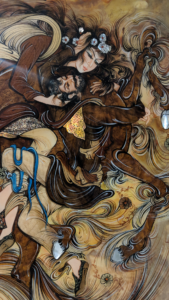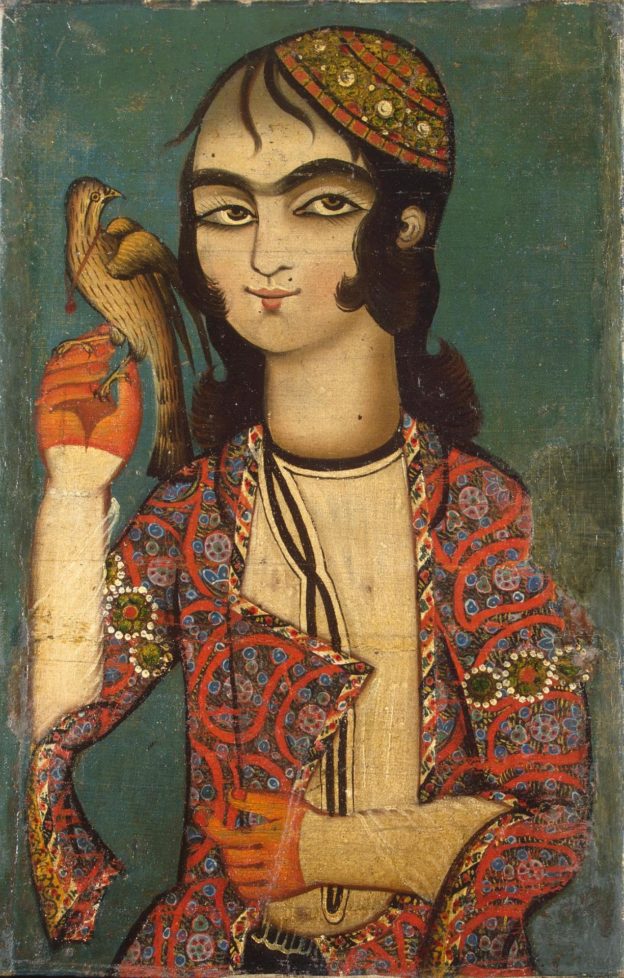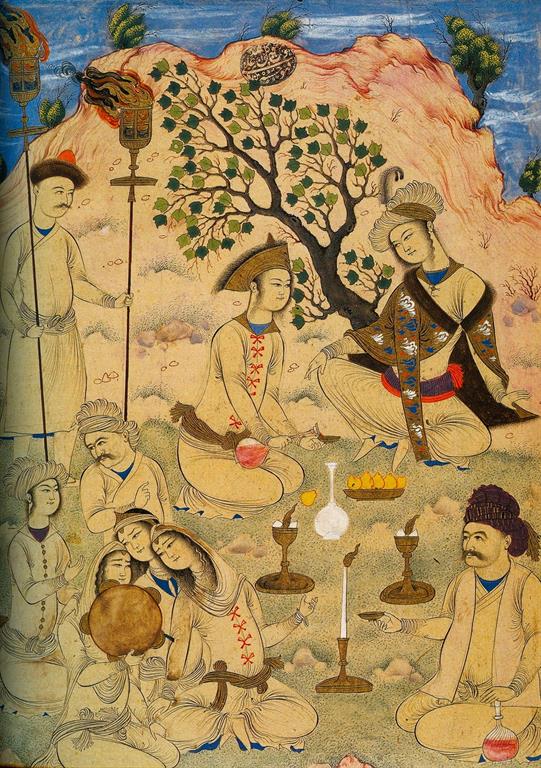
Come, I am lovesick and desolate without you
Come and see how sick I am in this sorrow without you
At night I lament your absence, oh fairy-faced,
And when the morning comes, it is as if I am on fire without you.
–Sa’di
With each return I see my mother’s home in sepia tones. Pan to her zereshk polo dish being served in technicolor, my father harvesting lemons in monochromatic static. Despite my nostalgia remembering these images in obscura, my parents’ home is luminous in color. The carmine Persian rug vining paisley knots, the precious saffron-stained rice tahdig my siblings and I fought over.
This is the house I grew up in. Next to the Starbucks we contested that leads the way to a labyrinth of forested suburban roads.
As a child I stared endlessly at the artwork ornamenting the walls. Behind glossy frames sumptuous Sultans looked to me with solemn almond eyes. The females adorned a single unibrow, akin to Frida, and a faint mustache. Their long, willowy bodies contrast the curves in the Renaissance paintings I saw in grade school. The men, too—with slender bodies and delicate, hairless faces—opposed western binaries.
If it weren’t for turbans and crowns, the bodies and faces of these painted figures would be indistinguishable. There was a muted poetry within these genderless humans that I tried to understand through my youth. As male peers implored I should man up, I must eat more, I’m too skinny (yet women, of course, must grow inversely), the characters in the paintings grew to deities. Why did they look so similar? What legacies did they know? My premonitions were foreshadowed by historic truths.

In 18th century Pre-Islamic Persia, young effeminate men, or nawkhatts, were the portrait of beauty [1]. Sexual mores permitted homosexuality, though as travel between Persia and Europe rose, Persian beauty ideals and sexual sensitivities shifted. Persia sought assimilation. The establishment of the first Iranian Muslim Kingdoms further ushered new cultural vicissitudes [2]. Overtime genderless figures and same-sex practices were cryptic taboos, reserved for panegyrics and portraits to carry on ancient secrets.
Visiting my parents in Saratoga, California, the bathroom mirror blurred my pedigree. I branched out my arms beneath photosynthetic fluorescence and pondered my thin frame. A century ago, would these soft contours belong to a unibrowed nawkhatt?
When we conjure medieval Persian folktales, we learn that their secular scriptures were purposed to praise a prince, an erotic love, and later, mystical verse reinforced the ambiguity in these messages.
Classic Persian literature dreams of imaginary utopias, where nothing vulgar or abrasive—including gender—can obtrude. Such is the ambiguity of genderless language and portraits, where gender is nothing more than abstraction, and unisex figures could be either a lover or a mystical god. In these vague panegyrics, we don’t know of the addressee is a lustful prince, a deity, or both.
Like a flower I shall embrace your love
And then switch off the light of reason.
I shall place my head between your breasts,
I drink love from the scent of your body.
–Homa Katouzian

The tropes among classic Persian poetry intertwine in ceaseless harmony with the artwork. Romantic adulations interlace with intricate rugs that allude to animals, structures, and plants–all entangled with entropic beauty. Rather than using a subject, classical Persian painters used imagination inspired by literature to create exotic scenes, resulting in dreamscape imagery free from western art conventions.According to Art History Professor W.J.T. Mitchell, polychromatic Persian visuals are inevitably contaminated by language, and that …the dialectic of word and image seems to be a constant in the fabric of signs that a culture weaves around itself [3].
Language, poetry, and divine praise spin and intertwine with myriad interpretations. Gender fragments from its binaries and enters a new ontology. Genderfluid becomes artfluid.
Let me offer a critical framework. In conversation with Julie Phelps, Judith Butler speaks on gender performativity at the 2013 Dance Discourse Project:
Look, we all emerge in the world entangled, like being caught in a web of gendered meanings, like this is what is a woman, this is what is a man, and there are norms and constraints and also ideas of pleasure.
And yet what’s really interesting is what people do in the middle of that web. It’s not like it’s forcing you to be one thing or another, or that you don’t have a choice or there’s no room to play. There is room to move and work in it and cut holes through it. So although we’re born into a sometimes very contradictory set of gender norms, they don’t determine who we are. We’re able to exercise what I would call agency in the midst of that entanglement.

In college I learned of cultural discourse patterns. The Eurocentric model asserts that you must stake your claim with evidence. Middle Eastern writings, conversely, are riddled with metaphors, spinning around one another, kaleidoscoping into new geometries of interpretation. Through my research gender revealed itself to be a Fibonacci sequence, tangled through colonial histories.
In Untitled 1396—as part of Hope Mohr Dance’s 2017 Bridge Project—Maryam Rostami lip synced classics from Persian pop icon Hayedeh. She danced in high-femme drag, sparkly gold Persian garbs juxtaposed with faux-cheerful expressions as a satirical wink to the audience. Her classic Persian dance moves are notable in Persian weddings and pop culture, a twist of the wrist like you’re screwing in a light bulb, arms curling upward, a twitch of the hips.
Yet there was something disquieting lurking in Untitled 1396, later revealed in Maryam’s journal readings. The solo work, named after the year used in the Iranian calendar corresponding roughly with 2017, asks “how does a Texas-born, Iranian-American Muslim femme deign to decolonize her body?'”
After seeing Maryam’s work, I gazed at the nawkhatt in my mother’s living room and wondered how one begins to unstitch the fabric of colonial histories within a body.
Last June at CounterPulse, trans performance artist Alok-Vaid Menon asked a related question: What feminine part of yourself did you have to destroy in order to survive in this world?
I reflect not only on interpersonal trajectories, but cultural assimilations throughout generations, dynasties. I think of the modern imprisonment, lashing, and execution of Iranian homosexuals–their flag unthreaded and restitched with non-secular and western threads long ago. I think of our own country’s current draconian transphobic regime. When the odyssey of non-binary folklore mends to imperial clout, my ancestry might offer some sense.
Back in Saratoga I flipped through photo albums with my mother. I smiled at the identical mushroom haircuts my sister and I had, given by my father and a cereal bowl. Her, ten years of age; me, six. In our baggy 90s garbs, gender hadn’t yet fully crystalized. I flipped to another page. The colors of these photos were fading to sepia, but the memories were as vibrant as the rug beneath us.
[1] Women with mustaches, men without beards; Beth Potier; The Harvard Gazette, 2002
[2] Persian Painting: A Visual Window into a Genderless Language, Najmeh Khatami; Pakistan Journal of Women’s Studies:Alam–e-Niswan, 2013
[3] Image and World; W.J.T Mitchell; Art Theory, 1986
This article appeared in the December 2018 edition of In Dance.


